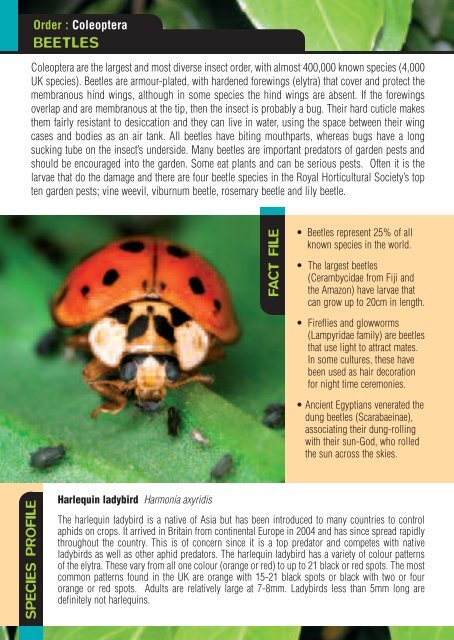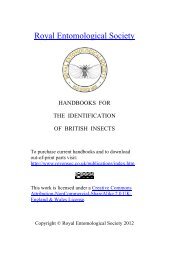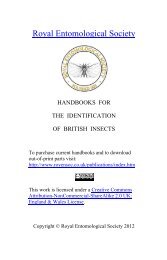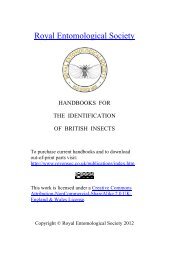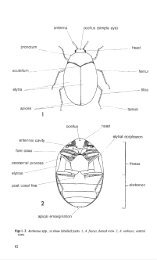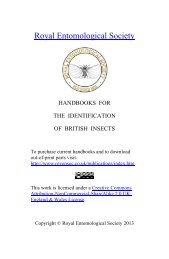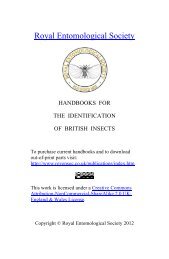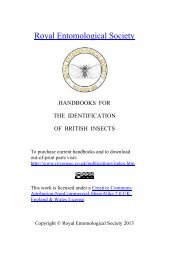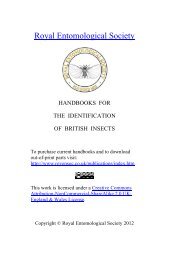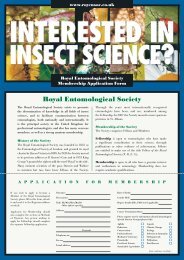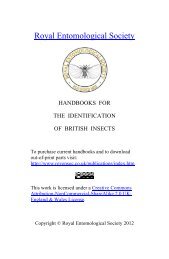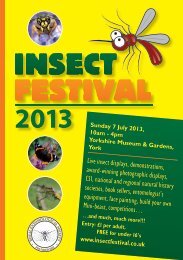Garden Entomology - Royal Entomological Society
Garden Entomology - Royal Entomological Society
Garden Entomology - Royal Entomological Society
Create successful ePaper yourself
Turn your PDF publications into a flip-book with our unique Google optimized e-Paper software.
SPECIES PROFILE<br />
Order : Coleoptera<br />
BEETLES<br />
Coleoptera are the largest and most diverse insect order, with almost 400,000 known species (4,000<br />
UK species). Beetles are armour-plated, with hardened forewings (elytra) that cover and protect the<br />
membranous hind wings, although in some species the hind wings are absent. If the forewings<br />
overlap and are membranous at the tip, then the insect is probably a bug. Their hard cuticle makes<br />
them fairly resistant to desiccation and they can live in water, using the space between their wing<br />
cases and bodies as an air tank. All beetles have biting mouthparts, whereas bugs have a long<br />
sucking tube on the insect’s underside. Many beetles are important predators of garden pests and<br />
should be encouraged into the garden. Some eat plants and can be serious pests. Often it is the<br />
larvae that do the damage and there are four beetle species in the <strong>Royal</strong> Horticultural <strong>Society</strong>’s top<br />
ten garden pests; vine weevil, viburnum beetle, rosemary beetle and lily beetle.<br />
FACT FILE<br />
• Beetles represent 25% of all<br />
known species in the world.<br />
• The largest beetles<br />
(Cerambycidae from Fiji and<br />
the Amazon) have larvae that<br />
can grow up to 20cm in length.<br />
• Fireflies and glowworms<br />
(Lampyridae family) are beetles<br />
that use light to attract mates.<br />
In some cultures, these have<br />
been used as hair decoration<br />
for night time ceremonies.<br />
• Ancient Egyptians venerated the<br />
dung beetles (Scarabaeinae),<br />
associating their dung-rolling<br />
with their sun-God, who rolled<br />
the sun across the skies.<br />
Harlequin ladybird Harmonia axyridis<br />
The harlequin ladybird is a native of Asia but has been introduced to many countries to control<br />
aphids on crops. It arrived in Britain from continental Europe in 2004 and has since spread rapidly<br />
throughout the country. This is of concern since it is a top predator and competes with native<br />
ladybirds as well as other aphid predators. The harlequin ladybird has a variety of colour patterns<br />
of the elytra. These vary from all one colour (orange or red) to up to 21 black or red spots. The most<br />
common patterns found in the UK are orange with 15-21 black spots or black with two or four<br />
orange or red spots. Adults are relatively large at 7-8mm. Ladybirds less than 5mm long are<br />
definitely not harlequins.


